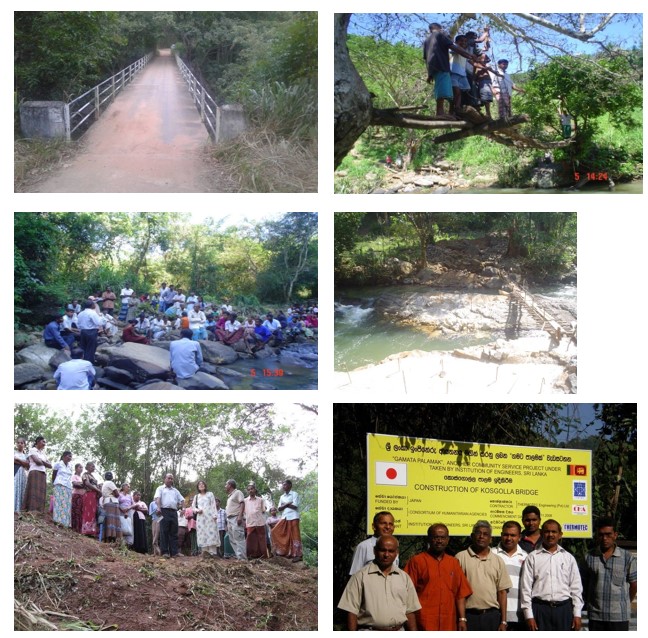The Kosgolla Bridge: A Catalyst for Community Transformation
BY Eng. Bandula Karunaratna
Abstract: The Kosgolla Bridge project, spanning the years 2006-2008, epitomizes the essence of community development. Initiated by the Mechanical Engineering Sectional Committee of the Institution of Engineers, Sri Lanka (IESL). Project was commissioned by "Ekamuthu Sarana Samithiya" and generously funded by the Government of Japan. Playing the leading role by me, as the IESL MESC our involvement in this endeavor was multifaceted, encompassing engineering consultancy, project management, and construction oversight.
Introduction: Rooted in the broader "Bridge to the Village" (Gamata Palamak) initiative by IESL, the Kosgolla Bridge aimed to address the pressing need for safe river crossings in the Badulla District, home to the renowned Dunhida waterfall. With a budget of Rs. 8 million financed by the Government of Japan, the project held the potential to become a lifeline for the local community.
Project Genesis and Challenges: The "Bridge to the Village" project initially envisioned repurposing discarded railway carriages from the Department of Railway to construct small bridges in rural areas. However, it faced two significant challenges: the transportation of railway chassis to the construction sites and the construction of cost-effective piers capable of withstanding substantial water flow. Overcoming these challenges was pivotal to ensuring safe passage across the main river for local villagers.
Feasibility Study: “Bridging Lives”; The feasibility study focused on securing funding for a pedestrian and light traffic bridge over Baduluoya at Kosgolla, connecting the villages of Dambagahamadiththa and Kosgolla. Approximately 250 residents, including schoolchildren, faced treacherous river crossings, compelling the initiation of this vital project. The study, conducted in collaboration with IESL Uva Center in Badulla, as a response to a formal request by "Ekamuthu Sarana Samithiya."
Existing Temporary Bridge: “A Perilous Crossing”; The existing wooden bridge posed grave dangers, especially during heavy rains, cutting off access to town and posing significant risks to travelers. This perilous crossing, coupled with fast-flowing river sections and an improvised footbridge strung between trees, underscored the urgency of the Kosgolla Bridge project.
Strategic Site Selection and Design: The selected bridge site, strategically located 500 meters downstream from the existing bridge, featured natural rock outcrops spaced approximately 11 meters apart. This location proved ideal for constructing piers, substantially reducing foundation costs while providing secure anchoring points. Designed for pedestrians and light traffic, the bridge accommodates vehicles like three-wheelers, not exceeding 200kg. The deck, made from discarded railway carriage chassis obtained through the "Gamata Palamak" Low-cost Bridges program, is elevated at 4800mm above the riverbed.
Construction and Collaborative Endeavors: Maximizing local resources to minimize costs, the project engaged villagers in material preparation and provided opportunities for unskilled and semi-skilled labor. Villagers actively contributed to constructing sections of the approach roads, fostering a sense of ownership and community involvement.
Cost-Efficient Approach and Timeline: Meticulously calculated construction costs, outlined in a Bill of Quantities, included foundations, the bridge deck, transportation, and a portion of the approach roads. Pricing was based on prevailing material costs, without allowances for contingencies. The project aimed for swift implementation, commencing construction during dry seasons and estimating a three to four-month construction timeline during such periods.
Cost/Benefit (better to use an appropriate word. If use Analysis, it needs to be shown with a quantitative approach like through figures and tables): “Amplifying Community Impact”; The project's costs, while modest compared to similar endeavors, promised immeasurable social impact for the residents of Dambagahamadiththa and Kosgolla. Safe river crossings, enhanced safety for schoolchildren, improved access for the vulnerable, economic opportunities for villagers, and increased social interaction were among the direct benefits. Indirect benefits encompassed improved security, access to medical services, disaster preparedness, tapping into villagers' talents, and boosting agricultural productivity.
Conclusion: A Bridge of Hope In conclusion, the Kosgolla Bridge represents a humanitarian imperative, enhancing the lives of approximately 250 impoverished residents. The project's emphasis on community participation and cost-effective techniques has kept construction expenses low, making it a socially impactful initiative. Beyond its monetary value, the bridge offers a brighter future to a marginalized community, highlighting the enduring importance of such endeavors in fostering hope and resilience.

 Eng. Bandula Karunaratna
Eng. Bandula Karunaratna
MEM, PG Dip. (BSE), C.Eng., B.Sc.Eng., MIE (SL),
MASHRAE (USA), MIIM (HK), ACIBSE (UK), GB(SL)AP
Consultant / Chartered Engineer,
Building Services + MEP infrastructure + Green Concept




